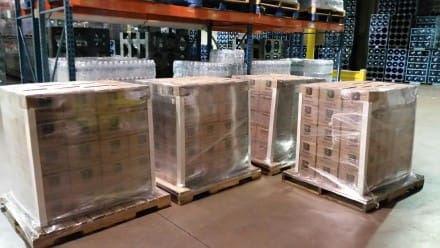Darley Defense showed me their Safe Water Box. The water is vacuum filled in a flexible bag, creating a barrier to oxygen and aroma, and placed in an outer board box protecting from light and air during the entire storage period, thus avoiding risk of bacterial contamination. This one-way packaging is compliant with hygienic requirements and makes packaged water affordable in a sustainable format. The bag and box are completely recyclable. Additionally, there is a tamper evident strip for food security.
The 82nd Airborne is using this during water resupply efforts during their training exercises at Fort Bragg and Fort Polk. Interstingly, they claim this is is cheaper and more effective to distribute to deployed forces than using the reusable 5 gallon jerry cans. For example, it can be configured as a CDs bundle. The cost to the 82nd Airborne is 50% cheaper than their previous water solution.
The Red Cross and FEMA are deploying this technology to hurricane stricken areas. They have 26 pallets of water going Puerto Rico this week. The Red Cross likes this bag in box packaging because one box can be given to a family and it can be easily utilized for drinking, cooking, hygiene. This is also significant because the long-term environmental footprint is substantially less compared to bottled water.
www.darley.com/pump-guide/product-water-purification/bag-in-box-water
Tags: Darley Defense



I bloody love water. Nearly the cheapest treat there is.
Genuinely, anything that gets more h2o to more people for less money with less waste and more safety.. I mean does a product get a lot better than that? Superb.
26 pallets of water? That’s a drop in the bucket. Sure, there are short-term limited uses for this product and others, but I’d like to see the arithmetic, and more importantly, the underlying assumptions, that support the claim that this packaged water is cheaper that bulk water distributed in 5 gallon cans.
Jerry cans while they are reusable cost money. No jerry cans = cost savings.
The question is not what it is distributed in but what is doing the distributing. If it’s privates and trucks sure, 5 gallons make sense, but if it’s being airlifted, every ounce of plastic jerry can is an ounce that could or should rather be water. Cardboard and thin plastic bags weigh significantly less than jerry cans, and if it’s a one way trip like most resupply runs are, then you save even more money and fuel.
I remember getting diesel delivered via chinook helicopter in Afghanistan, and calculating that it was about $200 a litre just to get it to us. Not counting the fuel itself.
We couldn’t find all the cans the BSB distributed, so I see where the savings would be! Additionally, cardboard can go out with the MRE dunnage….the bags can be used for something else….or also tossed with the MRE trash…”XO, where do we drop the trash?”